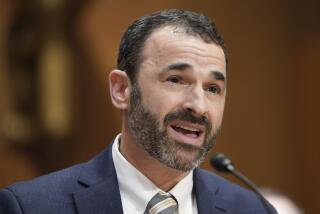Trump pitches tax plan as ‘once-in-a-generation opportunity,’ but leaves many issues unresolved
The Republican tax overhaul has a lot for businesses to like — and a lot of unanswered questions for everyone else.
According to the plan, which Republican officials outlined Wednesday, many businesses would see a huge reduction in their tax bills and many middle-class Americans would see tax relief. The plan would reduce the number of individual tax brackets to three from seven and nearly double the standard deduction.
“This is a once-in-a-generation opportunity” to offer “historic tax relief to the American people,” President Trump said as he pitched the plan during a speech in Indianapolis on Wednesday.
“I’ve been waiting for this for a long time.”
The release of the tax framework kicks off a scramble by lawmakers to hammer out the details, craft legislation and, if all goes according to plan, pass legislation by the end of the year.
Meeting that schedule won’t be easy, in part because President Trump has set out goals that to some extent contradict each other. Trump wants to cut taxes for business, a move that generally helps upper-income taxpayers. But he also has insisted that his plan won’t amount to a significant tax cut for wealthy Americans.
“My plan is for the working people and my plan is for jobs,” he said before leaving Washington for Indiana. “I think there’s very little benefit for people of wealth.”
That remains to be seen once the details emerge. Already, however, the framework shows that one particular group could be hit hard — upper-middle-income wage earners in states that have significant income taxes, such as California and New York.
The plan calls for eliminating the current deduction for payment of state and local taxes, which would hit hard at taxpayers in those states who itemize their deductions.
In 2014, Californians received $101 billion from the state and local tax deduction — nearly a third of the total value of the deduction nationwide, according to the nonpartisan Tax Foundation.
Most of those states with high taxes voted Democratic in the last presidential election.
Other crucial details for individual taxpayers have yet to be worked out, including the income levels for the new tax brackets and whether the individual tax cuts would favor the wealthy.
There’s more certainty for businesses.
The plan calls for slashing tax rates paid by corporations and so-called pass-through businesses, which range from mom-and-pop stores to law firms, hedge funds and other large partnerships that pay taxes based on the individual tax code.
The plan also fulfills other goals of the business community, including eliminating U.S. taxes on most foreign earnings and allowing companies to immediately write off the cost of new capital expenses instead of deducting them over time. The new expensing rules would last at least five years.
The U.S. Chamber of Commerce, which along with other business trade groups has been lobbying hard for a tax overhaul, said it was pleased with the outline.
“Now, we are entering into a crucial new phase of the effort to overhaul the tax code, and the hardest work is just beginning,” said Thomas J. Donohue, the chamber’s president.
Republicans are under great pressure to enact tax reform in the wake of their failure to pass a new healthcare law. The tax plan was met Wednesday with widespread support from GOP lawmakers on Capitol Hill and their allied groups.
But the details will matter. As legislation is drafted and analyzed and winners and losers become apparent, Republicans are almost certain to struggle to hold their majority together.
To make more room to maneuver, Trump hopes to gain some Democratic support for his plan. Tax cuts needn’t be a partisan issue, he said in Indiana. Just before he said so, however, he threatened the state’s Democratic senator, Joe Donnelly, a moderate who some White House officials have suggested might side with the tax plan.
If Donnelly didn’t support the tax plan, “we will come here, we will campaign against him like you wouldn’t believe,” he said, drawing some of his loudest applause from a partisan crowd.
One issue for Democrats, and some Republicans, is likely to be the impact on the federal deficit, which the tax plan would worsen by about $2.2 trillion over the next 10 years, according to a preliminary analysis by the Committee for a Responsible Federal Budget.
“Without sufficient details on how or even if these tax cuts will be fully paid for, this outline is nothing more than a fiscal fantasy,” said Maya MacGuineas, the group’s president.
Republican leaders have acknowledged that the plan initially would add to the budget deficit. They claim that stronger economic growth spurred by the tax cuts eventually would offset the deficit increase. Democrats challenge that, based on experience with past tax cuts.
House Minority Leader Nancy Pelosi (D-San Francisco) said Democrats have been willing to engage in “bipartisan tax reform,” but on Wednesday blasted the Republican outline as focused on the wealthy.
“Republicans’ tax framework is not tax reform, it is a framework that gives away the store to the wealthiest, while sticking the middle class with the bill,” she said.
Pelosi specifically objected to lowering the top tax rate and eliminating the estate tax while increasing the lowest tax rate and scrapping the state and local tax deduction.
The Republican plan would reduce the U.S. corporate tax rate to 20% from 35%. That’s not as low as Trump wanted, but would still be a gigantic reduction, to the lowest top rate since 1940.
Trump told reporters Wednesday that he would not agree to a corporate tax rate any higher than 20%.
That rate is “very much a red line,” Trump said. “I wanted 15, so we got 20: 20’s my number, so I’m not negotiating that number. I am not going to negotiate,” he said. “That’s the number I wanted to get to. I wanted to start at 15 to get there.”
Businesses have been lobbying heavily for a reduction in the corporate rate. The current U.S. rate is the highest among developed nations, although many companies pay a lower rate, if any tax at all, by using loopholes and deductions.
Pass-through businesses that pay taxes through the individual code, which include some of Trump’s family enterprises, would see their top tax rate drop to 25% from 39.6%.
The tax outline says that the plan “contemplates” that lawmakers drafting the legislation “will adopt measures” to prevent wealthy people from taking advantage of that new, low pass-through rate by recategorizing personal income as business income. That, however, would add a whole new layer of complexity to the tax code, at least for the wealthy, contradicting Trump’s argument that taxes should be simplified.
The plan would preserve deductions for mortgage interest and charitable contributions, but opens the door to scaling them back.
The standard deduction would nearly double, to $24,000 for married filers. That would be a major benefit to taxpayers who don’t have enough deductions, such as mortgage interest, to itemize.
ALSO:
The FBI is reportedly looking into practices of largest lender of PACE home-improvement loans
Trump leaves the Washington ‘swamp’ to dine with donors in Manhattan
Ivanka Trump’s business ties in China are shrouded in secrecy
UPDATES:
1:30 p.m.: This article was updated with quotes from President Trump’s speech in Indiana.
11 a.m.: This article was updated with comments from President Trump, reaction and additional details.
This article originally was published at 9:25 a.m.








